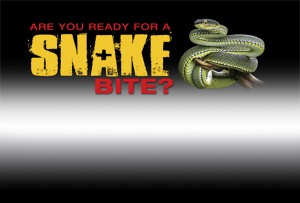Are you Ready for A Snake Bite?
By: Caroline Coile
 Every once in a while, I’ve done something smart. In this case, it was joining a Facebook group called National Snakebite Support group last year. Staffed by more than 30 experts in snake bite treatment, they are there to walk you through both human and veterinary snake bite cases. As a member, you can follow along on cases–making sure to never, ever comment, as that would be a distraction—and learn the rights and wrongs of snake bite treatment.
Every once in a while, I’ve done something smart. In this case, it was joining a Facebook group called National Snakebite Support group last year. Staffed by more than 30 experts in snake bite treatment, they are there to walk you through both human and veterinary snake bite cases. As a member, you can follow along on cases–making sure to never, ever comment, as that would be a distraction—and learn the rights and wrongs of snake bite treatment.
I had been following such posts vicariously for about a year when one Sunday afternoon one of my Salukis, Mecca, walked in the house with her entire face slathered in blood. I admit I was so surprised I screamed out loud. I rushed her to the shower to try to wash her off, but she was in too much pain to let me do much. But at least I could see her skin now, and instead of the giant gash from a raccoon or feral hog I’d been expecting, all I saw was a few tiny scrapes. Regardless, she was in obvious pain and needed an emergency visit to the vet.
By the time I’d called the vet and reported bleeding from an unknown cause, and started driving down the road, she’d had projectile diarrhea (twice) and vomited (twice). A snakebite worked its way to the top of my list—I see a few timber rattlers and eastern diamondbacks in the yard every year—so I turned around to shut the rest of the dogs in the house lest I return to more of the same.
From my time spent on the list I knew that while time was of the essence, she probably was not going to die en route, even though it was an hour-long trip. I knew there was really no first-aid I should be doing, and I knew what I needed my vet to do once we arrived. Some vets are more versed than others, and I was beyond relieved when my vet told me his treatment plan, which matched that of the NSS: Start an IV, do bloodwork, start IV pain meds, start anti-venom. (By the way, “anti-venom” and “antivenin” are basically synonyms, although technically antivenin is the subclass of anti-venom used to treat snake bites).
Unfortunately, not all owners are so lucky. Day after day posts relating wrong thinking resulting in wrong treatment come into the group. Here are some of the most common, with comments from one of NSS’s founders, Spencer Greene, MD, MS, FACEP, FACMT, FAAEM!
You can always identify a poisonous snake bite because it always has two puncture marks. FALSE Pit viper bites may have one or two fang marks, or even more if they’re from multiple bites. In some cases, you may not be able to find any puncture, although shaving the suspected area is helpful. While snake bites are more often not bloody, they can bleed profusely. In short, puncture wounds may be a clue, but don’t depend on them.
Bites from juvenile snakes are more dangerous than bites from adults. FALSE. According to Dr. Greene, this is a common misperception, based on the belief juveniles cannot control the amount of venom released. However, according to him, juveniles are as capable as adults of controlling venom release (and there is a recent paper that found no snakes control venom release, that it’s more a matter of strike force and resistance, so apparently that whole matter is still not definite). Regardless, juveniles simply don’t have the amount of venom that adults do, so are incapable of releasing as much even if they wanted to. Greene goes on to say that in some species the ratio of venom components changes with age. So, some toxins could be more potent in juveniles, but that on average, a bite from an adult is more serious than a bite from a juvenile. “The most important thing to remember is that every bite is unique, and a bite from any pit viper of any age has the potential to be mild, moderate, or severe.”
Be sure to identify the snake species: FALSE (sort of). The only identification needed is whether it’s a poisonous snake or a nonpoisonous one, in North America, whether it’s a pit viper (rattlesnake, water moccasin or copperhead) or a coral snake. All pit viper envenomation is treated with the same anti-venom. Treatment is not based upon the species of snake, but on clinical signs. Any bite with swelling, bruising, pain, or with gastrointestinal, respiratory, or cardiac signs, or with blood work indicating abnormal clotting factors, is a bite in which venom was injected, and thus a bite that needs to be treated. Take a picture if you can, but don’t endanger yourself doing so. And never bring a potentially poisonous snake, dead or alive, to the clinic! Remember that even severed snake heads can bite!
The rattlesnake vaccine will help. FALSE. In a study of 82 canine snakebite victims, the 14 that had received the rattlesnake vaccine did have a lower morbidity rate, but it was not statistically significant. “The findings of this study did not identify a significantly protective effect of previous vaccination in the cases of moderate to severe rattlesnake envenomation that require treatment with antivenin.” (DOI:10.2147/VMRR.S69216). The main problem is that too many people bypass anti-venom after receiving the vaccine in the false belief their dog is protected. But the immune system cannot produce enough antibodies fast enough after an envenomation to make a difference.
If it doesn’t hurt/swell/bruise immediately, it’s a dry bite. FALSE. About 10- 15% of pit viper bites are “dry bites,” in which the snake does not inject venom. “Snakebites are a dynamic process,” says Dr. Greene, speaking of his human patients. “The diagnosis of dry bite cannot be made after 30 minutes of observation. Not even two hours. Not even four hours. Patients who may have been bitten by a venomous snake should be observed for AT LEAST eight hours. If there are no local findings, no systemic toxicity, and no hematologic lab abnormalities, then it is reasonable to make the diagnosis of a dry bite. To call it a dry bite after one hour of observation is a recipe for disaster.”
Use a snake bite kit to suction out the venom. FALSE. These devices remove almost no venom following a bite (no more than 2% in one study), take time to use, and may theoretically concentrate the venom by suctioning out interstitial cell fluid. The same goes for sucking the wound. Don’t do it.
Use a tourniquet or constriction bandage to slow the spread of venom. FALSE. Pit viper bites cause most of their problems (swelling, bruising, pain, tissue death) in the tissue surrounding the bite. You need to avoid any technique that possibly confines the venom in one area. And if performed incorrectly, it can a increase systemic venom absorption while still allowing significant local tissue damage. Don’t do it.
Use electric current to combat venom. FALSE. Really? People somehow got this idea, and a few have died from it. Don’t do it.
Give Benadryl to reduce swelling. FALSE. This is one of the most common bits of incorrect information. Benadryl is an antihistamine. But histamine is not a major component of snake venom. Benadryl or any other antihistamine is a total waste of time and gives people a false sense of security. “The only time Benadryl may be helpful is in the rare case of an allergic reaction to either the venom or the anti-venom,” explains Greene. “And in serious reactions, the drug of choice would be epinephrine, not Benadryl.”
Give an NSAID to control pain. FALSE. NSAIDs increase bleeding tendencies, which are already increased by the venom. They can be harmful.
Give a corticosteroid to control swelling. FALSE. The toxins in snake venom, and the redness, swelling, and pain they cause, are totally unaffected by corticosteroids. They are of no value.
Give subcutaneous fluids. FALSE. Venom increases bleeding and bruising, which subcutaneous fluid administration also causes. They can be harmful.
Give antibiotics to prevent infection. FALSE. It’s rare for a snake bite to become infected. If it does, treat it then. Otherwise, antibiotics are of no value. Antibiotics should not be prescribed routinely following snakebite.
Snake bites don’t hurt. FALSE. People describe the pit viper snakebite as feeling on fire, and the “worst pain they’ve ever felt.” This is why opioid pain medication is a mainstay of snake bite treatment. NSAIDs and over-the-counter medications will not touch the pain. Tramadol, commonly prescribed, has recently been found to be a poor pain medication overall for dogs, but can be somewhat effective when paired with gabapentin. But the better choice is IV opioids, and this is one reason it is preferable to leave your dog at a veterinary clinic (assuming somebody will be there monitoring) for 24 hours rather than bring the dog home.
All veterinarians are well-versed at snakebite treatment. FALSE. Too many veterinarians advocate giving Benadryl, antibiotics and even corticosteroids instead of antivenom. They may not stock antivenom, or may not be comfortable with administering it, or may not have the time to give it properly (it takes about an hour to deliver one vial as it must be slowly infused.)
The snakebite severity scoring system is a good guideline for treatment. FALSE. The snake bite severity scoring (SSS) system is a series of questions asking you to score from 1 to 5 such things as extent of pain, swelling, gastrointestinal upset, or breathing difficulties. The scores are then added up and if above a certain number, treatment with antivenom is suggested. Dr. Greene points out that the SSS was created as a research tool, not a treatment guide, and that patients with a very high score in one area but low in others may have low total scores but still need treatment. If your dog is having difficulty breathing but no other signs, do you really think he’s had enough antivenom? Although his comments are directed at human medicine, the same is true for dogs: “If you or a loved one is ever in the hospital with a snakebite and your physician is not treating you because your ‘score’ is too low, you need to have a frank discussion with him or her. Most people use the unified algorithm as a guide.”
Most bites don’t require antivenom. FALSE. Antivenom is the only treatment that can directly fight venom. Antivenom binds to the toxin and prevents it from damaging tissue cells. It’s true that antivenom is very expensive: around $400 to $1000 a vial. Most dogs will receive one to four vials. It’s also true that not every veterinarian carries it; call ahead to make sure before rushing to the clinic because it’s better to go to a clinic farther away with antivenom than one close without (the exception being if you can get pain medications on board for the rest of the trip there).
Copperhead bites aren’t serious enough for antivenom. FALSE. While it is true that rattlesnake and water moccasin bites can be more serious, any pit viper bite can be serious. Dr. Greene advocates that treatment should be based on clinical findings, not what species is responsible. Copperhead bites have caused deaths and permanent disabilities in people—and they can cause significant pain. He also points out that most people aren’t necessarily great at telling one snake species from another.
Antivenom has risky side effects. FALSE. The chance of an allergic reaction to antivenom exists, but is extremely small, and if it does occur, is treatable with epinephrine.
Once a dog receives antivenom, they can never get it again. FALSE. Just false. Antivenom is only useful if given within an hour or two. FALSE. While it is true that “time is tissue” and the sooner the better as far as antivenom administration, antivenom can still be helpful hours, even 24 hours, after the bite. In fact, some evidence shows some benefits even if given up to two or three days later.
Tissue necrosis warrants immediate tissue removal or even amputation: FALSE. While necrosis can occur, especially if antivenom was not administered or was administered after a delay, it’s often just the superficial tissue and will slough off. It should be treated with superficial wound care. Only full-thickness necrosis warrants amputation.
Keep the snakebite lower than the heart. FALSE. The old school said to do this prevent the venom from being pumped around the body, but in fact this doesn’t affect it that much, and in most cases, the majority of damage from a bite is local tissue damage. “The volume of venom is incredibly small,” says Dr. Greene, speaking of human patients, “and the effect of elevation on venom absorption is minimal. However, by elevating the affected extremity, we can significantly reduce the hydrostatic pressure that leads to swelling and tissue damage. It’s one of the first things I do, and the benefit is often obvious within 30 minutes.” The joint between the bite and the body should be kept straight. That said, good luck positioning your dog like this.
When it comes to coral snakes, red on yellow, he’s a good fellow. FALSE. First of all, nobody can recall the rhymes, and second, they are neither accurate nor dependable. People have received extremely serious bites from coral snakes because they either remembered the rhymes wrong or the snake they found was one of many variants. Take its picture and stay away.
Coral snakes have to chew to bite. FALSE. While it’s true they have small fangs, the fangs are still in the front of their mouth, and they can still strike and bite.
There’s no treatment for a coral snake bite. FALSE. Coral snake venom is not affected by pit viper antivenom. Coral snake antivenom is available, but it can be difficult to get. Although up to 25% (30-50% according to another source) of coral snake bites don’t contain toxins, those that do can be deadly. Coral snakes in Florida and South Georgia are the deadliest; the farther west (Texas, Arizona) the less toxic they are. Coral snake envenomation does not result in local swelling or bruising. The toxin acts on the nervous system, causing numbness and paralysis. The antivenom can stop the advancement of the paralysis but cannot reverse it. If your dog is bitten by a coral snake, you should take it to a vet school or advanced ER for observation. It can take two hours for signs to show up. The problem is that once paralysis reaches the diaphragm, the dog won’t be able to breathe and will need to be placed on a ventilator to survive.
So, what should you do? First, join the National Snakebite Support group on Facebook (https://www.facebook.com/groups/national. snakebite.support) and be sure to read and follow their rules. Second, find out what kind of snakes are in your area. Third, talk to your veterinarian about what you should do if your dog is bitten. Does the treatment plan include IV pain medication and antivenom? (Good). Does the clinic stock antivenom? Or does the treatment plan consist of Benadryl, steroids, and antibiotics? If so, can you steer them to the NSS? If not, find another clinic for your snake bite emergencies.
Short URL: https://caninechronicle.com/?p=289267
Comments are closed












